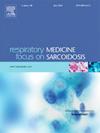支气管内瓣膜治疗可改善慢性阻塞性肺疾病患者的胸部 CT 横膈膜结构。
IF 3.5
3区 医学
Q2 CARDIAC & CARDIOVASCULAR SYSTEMS
引用次数: 0
摘要
本研究探讨了使用支气管内瓣膜(EBV)进行支气管镜肺容积缩小治疗对膈肌结构的影响。我们使用一种新开发的定量计算机断层扫描(QCT)工具,成功地分析了四十名重度肺气肿患者在接受 EBV 治疗前后的膈肌指数。我们使用 Spearman's rho 评估了横膈膜指数的变化是否与 1 秒用力呼气容积 (FEV1)、残气量 (RV)、圣乔治呼吸问卷 (SGRQ) 和 6 分钟步行距离 (6MWD) 的改善相关。EBV 治疗仅影响治疗侧的膈肌结构,导致膈肌弧度增加。接受治疗的肺侧或整个横膈膜的相对横膈膜指数变化与 FEV1 和 6MWD 的改善有明显关联。这些发现为了解 EBV 治疗如何影响慢性阻塞性肺病患者的横膈膜提供了宝贵的见解。本文章由计算机程序翻译,如有差异,请以英文原文为准。
Endobronchial valve treatment improves chest-CT diaphragm configuration in COPD
This study investigated the impact of bronchoscopic lung volume reduction treatment using endobronchial valves (EBV) on diaphragm configuration. We successfully analyzed the diaphragm index using a newly developed quantitative computed tomography (QCT) tool before and after EBV treatment in forty patients with severe emphysema. We evaluated whether changes in the diaphragm index were associated with improvements in forced expiratory volume in 1 s (FEV1), residual volume (RV), Saint Georges Respiratory Questionnaire (SGRQ), and 6-min walking distance (6MWD) using Spearman's rho. The EBV treatment influenced the diaphragm configuration only on the treated side, resulting in an increased diaphragm curvature. There were significant associations of relative diaphragm index changes on the treated lung side or the entire diaphragm with improvements in FEV1 and 6MWD. These findings provide valuable insights into how EBV treatment affects the diaphragm in COPD patients.
求助全文
通过发布文献求助,成功后即可免费获取论文全文。
去求助
来源期刊

Respiratory medicine
医学-呼吸系统
CiteScore
7.50
自引率
0.00%
发文量
199
审稿时长
38 days
期刊介绍:
Respiratory Medicine is an internationally-renowned journal devoted to the rapid publication of clinically-relevant respiratory medicine research. It combines cutting-edge original research with state-of-the-art reviews dealing with all aspects of respiratory diseases and therapeutic interventions. Topics include adult and paediatric medicine, epidemiology, immunology and cell biology, physiology, occupational disorders, and the role of allergens and pollutants.
Respiratory Medicine is increasingly the journal of choice for publication of phased trial work, commenting on effectiveness, dosage and methods of action.
 求助内容:
求助内容: 应助结果提醒方式:
应助结果提醒方式:


